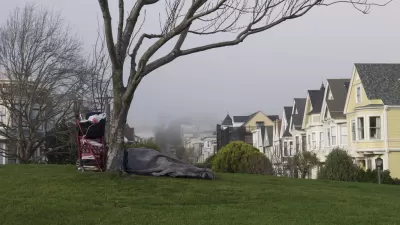Two primary strategies will help to achieve affordable living: Reduce household transportation costs and support smaller living spaces.

Housing is too expensive in some of America's major metropolitan areas, and something must be done about it. However, it would be a tragic mistake to focus only on the cost of rent, or the sales prices of homes. As we work to bring down housing costs, we also need to make affordable options available in other aspects of people's lives which can offset high rent. There are two primary areas that we should focus on in order to promote affordable living:
1. Reduce household transportation costs
Unaffordable housing is a serious problem, but the combined cost of housing and transportation is what really matters. In regions with affordability problems, housing and transportation costs tend to be inversely related. As housing gets cheaper toward the metropolitan fringe, transportation costs increase, often erasing the benefit of the lower-cost housing. For example, someone living in New York's Greenwich Village will undoubtably pay exorbitant rent, but due to the neighborhood's high walkability, abundance of amenities, and excellent transit access, their transportation costs can be nearly zero. If the same person moves out to suburban New Jersey they can get a cheaper house, but their transportation costs will skyrocket.
2. Support smaller living spaces
The average American home has been getting bigger (and bigger, and bigger) for a long time. In the 1950s the average home was only 980 square feet, but by the 2000s it was 2,300 square feet, despite the fact that the average household has fewer people now. There are a lot of perks to living in a large house, but there are also some downsides. Big homes take up more space, cost more to build, cost more to heat and cool, and cost more to furnish and equip. Inordinately large home can create serious financial strain for some households, especially in areas where rent and mortgage costs are exceptionally high.
FULL STORY: Do we need affordable housing or affordable living?

Trump Administration Could Effectively End Housing Voucher Program
Federal officials are eyeing major cuts to the Section 8 program that helps millions of low-income households pay rent.

Planetizen Federal Action Tracker
A weekly monitor of how Trump’s orders and actions are impacting planners and planning in America.

Ken Jennings Launches Transit Web Series
The Jeopardy champ wants you to ride public transit.

Crime Continues to Drop on Philly, San Francisco Transit Systems
SEPTA and BART both saw significant declines in violent crime in the first quarter of 2025.

How South LA Green Spaces Power Community Health and Hope
Green spaces like South L.A. Wetlands Park are helping South Los Angeles residents promote healthy lifestyles, build community, and advocate for improvements that reflect local needs in historically underserved neighborhoods.

Sacramento Plans ‘Quick-Build’ Road Safety Projects
The city wants to accelerate small-scale safety improvements that use low-cost equipment to make an impact at dangerous intersections.
Urban Design for Planners 1: Software Tools
This six-course series explores essential urban design concepts using open source software and equips planners with the tools they need to participate fully in the urban design process.
Planning for Universal Design
Learn the tools for implementing Universal Design in planning regulations.
Heyer Gruel & Associates PA
Ada County Highway District
Institute for Housing and Urban Development Studies (IHS)
City of Grandview
Harvard GSD Executive Education
Toledo-Lucas County Plan Commissions
Salt Lake City
NYU Wagner Graduate School of Public Service


























